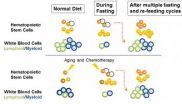(Press-News.org) (SACRAMENTO, Calif.) — In the wake of recent revelations of overly long patient wait times and systematic manipulation and falsification of reported wait-time data, UC Davis and Harvard public policy leaders believe the Department of Veterans Affairs (VA) health-care system's problems can be fixed by strong leadership, greater transparency and reforms that refocus the organization on its primary mission of providing timely access to consistently high-quality care.
In their Perspective article, published online June 4 in the New England Journal of Medicine, authors Kenneth W. Kizer and Ashish K. Jha provide new insights into the causes behind the VA's decline in safe, effective, patient-centered care and propose several first steps to help restore trust in the system.
Both physicians are among few who can provide an insider's view of challenges within the VA health-care system. Kizer served as undersecretary for health in the Department of Veterans Affairs from 1994 through 1999 and is credited with fundamentally transforming the system — an effort widely viewed as the largest and most successful health-care turnaround in U.S. history. He is now director of the UC Davis Institute for Population Health Improvement and a distinguished professor at the UC Davis School of Medicine and Betty Irene Moore School of Nursing.
Jha is a professor of Health Policy at the Harvard School of Public Health and a practicing general internist at the Boston VA Medical Center and the Brigham and Women's Hospital in Boston.
"Inadequate numbers of primary care providers, aged facilities, overly complicated scheduling processes and other difficult challenges have thwarted the VA's efforts to meet soaring demand for services," the authors stated in the article. "For years, it has been no secret that the VA's front lines of care delivery are understaffed for the needs.
"And though there can be no excuse for falsifying data, we believe that VA leadership created a toxic milieu when it imposed an unrealistic performance standard and placed high priority on meeting it in the face of these difficult challenges. They further compounded the situation by using a severely flawed wait-time monitoring system and expressing a 'no excuses' management attitude," they wrote.
The authors specifically identified three major causes of the decline in superior quality of care that became the hallmark of VA health care in the late 1990s:
An unfocused performance-measurement program, which changed from having about two dozen credible quality measures in the 1990s to hundreds used today that make it difficult to know which performance initiatives are truly important.
A shift from local facilities and regional-network managers bearing responsibility for the day-to-day operations to meet clearly articulated performance goals to an increasingly centralized control of care delivery and associated increased bureaucracy. For example, the Veteran Health Administration's central office grew from about 800 in the late 1990s to nearly 11,000 in 2012. (VHA is the sub-cabinet agency within the Department of Veterans Affairs that runs the VA health care system.)
Increasing organizational insularity, with less and less engagement with private-sector health-care providers in recent years and limited participation in national public reporting programs such as Hospital Compare and the Leapfrog Group to assess patient safety.
To start the process of returning the VA to its previous level of delivering superior quality of care, Kizer and Jha suggest the following next steps:
Ensure all veterans on wait lists are screened and triaged for care as quickly as possible.
Refocus the performance management system on fewer measures that directly address what is most important to patients and clinicians. VA's recent development of the Strategic Analytics for Improvement and Learning dashboard is a "good start," the authors state.
Design a new access strategy based on the concept of a "continuous healing relationship" that draws on modern information and advanced communication technologies to facilitate caregiver-patient connectivity 24/7/365.
Engage more with private-sector health-care organizations and the general public by participating fully in performance reporting forums, expanding learning and improvement partnerships with private-sector providers, and making performance data broadly available.
The authors conclude, importantly, that the VA employs "an army of highly dedicated clinicians and administrators who are deeply committed to providing high-quality care to veterans" and that the agency's problems can be fixed if new leadership helps them succeed.
INFORMATION:
UC Davis Health System is improving lives and transforming health care by providing excellent patient care, conducting groundbreaking research, fostering innovative, interprofessional education, and creating dynamic, productive partnerships with the community. The academic health system includes one of the country's best medical schools, a 619-bed acute-care teaching hospital, a 1,000-member physician's practice group and the new Betty Irene Moore School of Nursing. For more information, visit healthsystem.ucdavis.edu.
Restoring trust in VA health care
2014-06-05
ELSE PRESS RELEASES FROM THIS DATE:
NASA sees remnants of Tropical Storm Boris merging with Gulf low
2014-06-05
VIDEO:
TRMM satellite data showed that some areas in southwestern Mexico received over 12 inches of rainfall (red) from Boris, while System 90L on the eastern side of Mexico brought similar...
Click here for more information.
The remnants of former Tropical Storm Boris moved over southern Mexico and NASA and NOAA satellite data showed that they were merging with a low pressure area in the southwestern Gulf of Mexico. In addition, data from NASA's TRMM satellite was used to compile ...
New therapy for pancreatic cancer patients shows promising results
2014-06-05
SCOTTSDALE, Ariz. — June 5, 2014 — A clinical trial conducted by researchers at the Virginia G. Piper Cancer Center Clinical Trials, a partnership between Scottsdale Healthcare and the Translational Genomics Research Institute (TGen), showed that a new drug called MM-398, given in combination with 5-flourouracil (5FU) and leucovorin, produced a significant overall survival rate in patients with advanced, previously-treated pancreatic cancer.
The NAPOLI-1 (NAnoliPOsomaL Irinotecan) Phase 3 study — a final confirmation of a drug's safety and effectiveness — was conducted ...
Team finds on-off switch to burning stored fat
2014-06-05
SAN ANTONIO, Texas (June 5, 2014) — Scientists this week reported that a molecular pathway called mTORC1 controls the conversion of unhealthy white fat into beige fat, an appealing target for increasing energy expenditure and reducing obesity. The team, led by researchers from the School of Medicine at The University of Texas Health Science Center at San Antonio, also found that a protein, Grb10, serves as the on-off switch for mTORC1 signaling and the "beigeing" of fat.
The finding could inform development of novel diabetes and obesity drugs, the scientists said. The ...
How do phytoplankton survive a scarcity of a critical nutrient?
2014-06-05
Phytoplankton—tiny, photosynthetic organisms—are essential to life on Earth, supplying us with roughly half the oxygen we breathe. Like all other life forms, phytoplankton require the element phosphorus to carry out critical cellular activity, but in some parts of the world's ocean, P is in limited supply. How do phytoplankton survive when phosphorus is difficult to find?
Phytoplankton can alter their biochemical make-up according to the availability of nutrients in the water. When phosphorus (P) is particularly abundant in the water, phytoplankton produce and store ...
Stimulating a protein in skin cells could improve psoriasis symptoms
2014-06-05
Psoriasis is a common, long-lasting disease that causes itchy or sore patches of thick, red skin with silvery scales. Environmental contaminants can trigger psoriasis and other autoimmune disorders, and it is thought that a protein called the aryl hydrocarbon receptor (AhR), which senses environmental toxins, could play a role. A study published by Cell Press on June 5 in the journal Immunity shows that the severity of inflammation associated with psoriasis is unexpectedly suppressed by AhR. The findings suggest that stimulation of AhR could improve symptoms and may represent ...
Neurons transplanted into Parkinson's-affected brains appear healthy after 14 years
2014-06-05
When transplanted into the midbrains of adult patients with Parkinson's disease, dopamine neurons derived from fetal tissue can remain healthy for many years. The findings reported in the Cell Press journal Cell Reports on June 5th suggest that transplanted neurons don't degenerate over time as some had suggested and feared they would, which provides further rationale for pursuing stem cells as a source for transplant-ready dopamine neurons, according to the researchers.
"Our findings show a robust expression of dopamine transporters and a lack of abnormal mitochondrial ...
Activating the immune system could treat obesity and diabetes
2014-06-05
Obesity is a worldwide epidemic that is causing alarming rates of diabetes and cardiovascular disease, but currently there is a lack of effective drug treatments. Two unrelated studies published by Cell Press June 5th in the journal Cell reveal an important role for immune pathways in activating good types body fat, called brown and beige fat, which burn stored calories, reduce weight, and improve metabolic health. The findings could pave the way for much-needed treatments for obesity and related metabolic diseases.
"The idea that metabolic health can be improved by activation ...
Fasting may help protect against immune-related effects of chemotherapy and aging
2014-06-05
While chemotherapy can save lives, it can also cause many side effects, including the depletion of immune cells. Also, even in the absence of chemotherapy, normal aging takes a heavy toll on the immune system, leading to immune deficiencies and a higher risk of developing leukemia and a variety of malignancies with age. Now researchers reporting in the June 5th issue of the Cell Press journal Cell Stem Cell have found that a simple dietary intervention—periodic fasting—may combat both chemotherapy-induced and aging-related changes in immune cell function by replenishing ...
Outcomes of a 2-year national rare disease gene discovery project
2014-06-05
OTTAWA, ON – June 5, 2014 – As part of the Finding of Rare Disease Genes (FORGE) research project, Canadian researchers have developed an expertise in understanding the underlying biology of rare childhood disorders. The first public commentary of this nationwide study is available today in the American Journal of Human Genetics.
"When we launched this project, we predicted we might explain, or solve, 50 disorders; we've almost tripled that goal," said Dr. Kym Boycott, lead investigator of FORGE and clinician scientist at the Children's Hospital of Eastern Ontario ...
First 3-D pterosaur eggs found with their parents
2014-06-05
Researchers have discovered the first three-dimensionally preserved pterosaur eggs in China. The eggs were found among dozens, if not hundreds, of pterosaur fossils, representing a new genus and species (Hamipterus tianshanensis). The discovery, described in the Cell Press journal Current Biology on June 5, reveals that the pterosaurs—flying reptiles with wingspans ranging from 25 cm to 12 m—lived together in gregarious colonies.
Xiaolin Wang of the Chinese Academy of Sciences' Institute of Vertebrate Paleontology and Paleoanthropology says it was most exciting to find ...




